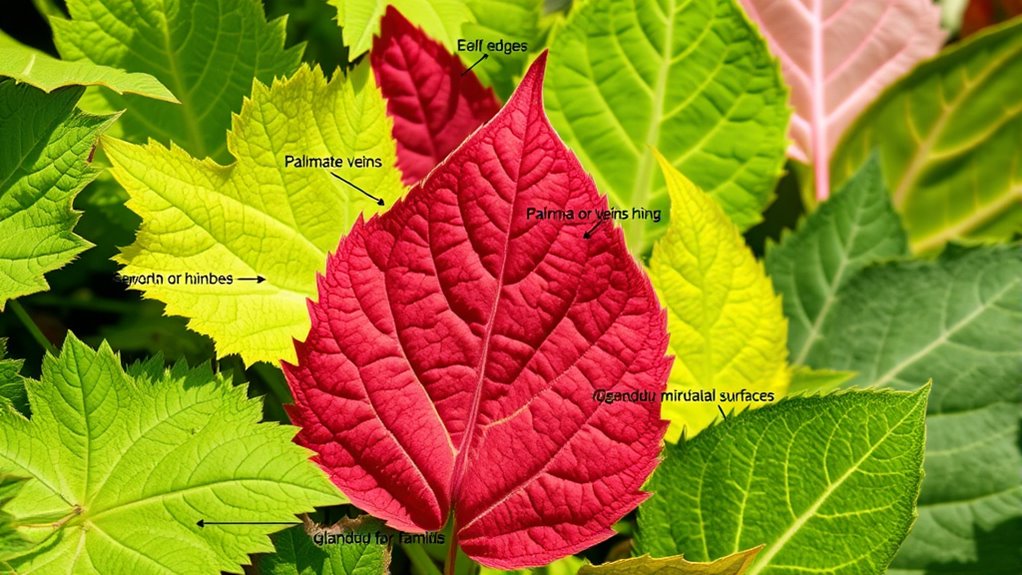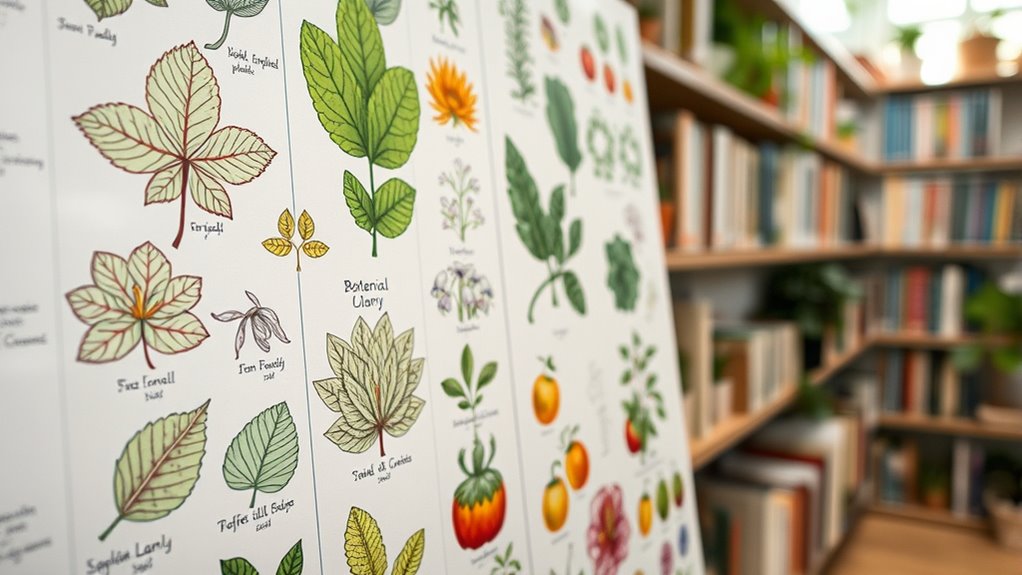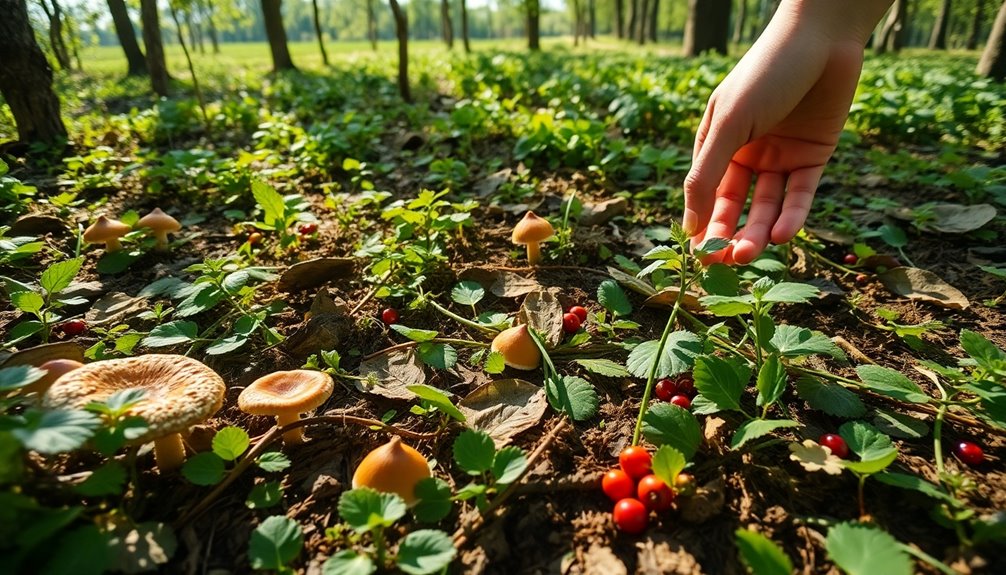To understand plant families and make identification easier, focus on common traits like leaf arrangement, flower structure, and fruit type. Recognizing these features helps you group plants based on shared characteristics and evolutionary relationships. Use guides, apps, and field observations to build confidence and accuracy. By studying how plants differentiate within families, you’ll quickly narrow down options. Keep exploring these clues, and you’ll improve your plant ID skills with greater ease.
Key Takeaways
- Learn key morphological traits like leaf arrangement, flower structure, and fruit type to distinguish plant families easily.
- Use field guides, identification keys, and digital resources to compare plants and recognize family characteristics.
- Understand genetic markers and phylogenetic data to confirm family groupings beyond visual features.
- Observe environmental and habitat clues alongside plant morphology for accurate family identification.
- Study evolutionary relationships and shared traits to predict features of unfamiliar plants within families.
The Importance of Recognizing Plant Families

Understanding plant families is essential because it helps you identify plants more accurately and efficiently. Recognizing plant families provides insights into plant family evolution, revealing how different groups have developed over time. By understanding these evolutionary relationships, you can distinguish plants that might look similar but belong to different families. Genetic markers play a vital role, acting as biological fingerprints that confirm family groupings. These markers help you trace lineage and clarify classifications, making identification more precise. When you learn to recognize plant families, you’re better equipped to predict plant behaviors, ecological roles, and potential uses. Additionally, understanding specific plant structures can aid in identification and classification. This knowledge simplifies your plant identification process, saves time, and enhances your overall understanding of plant diversity and evolution.
Key Characteristics of Major Plant Families

You can often identify plant families by examining their leaf arrangements and flower structures. Noticing whether leaves are opposite, alternate, or whorled helps distinguish different groups, while flower variations reveal key family traits. Paying attention to these characteristics makes plant identification clearer and more accurate. Observing specific flower structures can further aid in accurate classification by highlighting distinctive family features.
Leaf Arrangement Patterns
Have you ever noticed how leaves are arranged on different plant stems? The leaf pattern, or arrangement diversity, is a key characteristic that helps identify plant families. Some plants have opposite leaves, where two leaves grow directly across from each other on the stem. Others display alternate arrangements, with leaves growing one after another along the stem. Whorled patterns, where several leaves circle the stem at the same level, are also common. These arrangements influence how a plant captures sunlight and manages water. Recognizing these patterns makes plant identification easier. By observing leaf arrangement, you can narrow down plant family options quickly. Pay attention to whether leaves are spaced evenly, clustered, or spiraled, as these details reveal important clues about the plant’s classification. Leaf arrangement patterns also impact a plant’s adaptability to its environment, making this a useful trait to consider in identification.
Flower Structure Variations
Ever wondered how flower structures help distinguish plant families? The variations in flower color and petal arrangement are key identifiers. For example:
- Some families, like the Asteraceae, have composite flower heads with numerous small florets, often with vibrant colors.
- Others, such as the Ranunculaceae, feature flowers with a specific petal arrangement—typically five petals that are often irregular or asymmetrical.
- Many families, like the Liliaceae, display prominent, showy petals arranged symmetrically, emphasizing flower symmetry in flower structure.
- Understanding these differences helps you identify plant families quickly. Notice how flower color varies from bright reds and yellows to subtle pastels, and how petal arrangements can be simple or complex. These variations are essential clues in plant identification, making it easier to recognize and differentiate plant families in the field.
Using Leaf Shape and Arrangement to Identify Families

Leaf shape and arrangement are essential clues for identifying plant families. The shape of the leaf, such as oval or needle-like, combined with its margin—smooth, serrated, or lobed—helps narrow down options. Additionally, leaf venation patterns, like parallel or networked veins, are distinctive features. Consider this table to visualize these traits:
| Leaf Shape | Leaf Margin | Venation Pattern |
|---|---|---|
| Oval | Serrated | Parallel |
| Needle-like | Lobed | Net-like |
| Heart-shaped | Smooth | Pinnate |
Understanding these traits can also be influenced by emotional alignment, which plays a role in how plants and humans can be connected through nature.
Flower Structure and Its Role in Family Identification

Flower structure provides crucial clues for identifying plant families, often more reliable than leaf traits alone. By examining features like flower color and petal arrangement, you can distinguish between families more accurately. For example, consider these key aspects:
- Flower color – Some families have characteristic hues, such as the bright yellows of the sunflower family.
- Petal arrangement – Look at whether petals are fused or separate, and their symmetry, which varies among families.
- Number of petals – Specific flower families tend to have a consistent number of petals, aiding identification.
Pay attention to these details, as they offer indispensable clues. Recognizing patterns in flower structure simplifies the process of correctly classifying plant families and deepens your understanding of plant diversity.
Fruit Types and Their Significance in Classifying Plant Families

Fruit types vary widely among plant families and hold key clues for classification. You’ll notice differences between edible and non-edible fruits, which often reflect evolutionary adaptations. Recognizing these distinctions helps you understand how fruit morphology influences family grouping and plant identification. Additionally, understanding vetted information can assist in accurately identifying plant families based on fruit characteristics.
Fruit Morphology and Types
Have you ever wondered how the shape and structure of a fruit can reveal a plant’s family? Fruit morphology varies widely and plays a key role in classification. For example, understanding:
- The type of fruit, such as a berry, capsule, or drupe, helps identify plant families based on how seeds are dispersed.
- Fruit color, which can attract specific dispersers and signal maturity, often correlates with certain family traits.
- The seed dispersal mechanism, whether by animals, wind, or water, influences fruit structure and is characteristic of particular groups.
- Recognizing fruit morphology patterns can aid botanists in quickly sorting plants into broader taxonomic categories.
Edible vs. Non-Edible Fruits
Ever wondered why some fruits are enjoyed as tasty treats while others are avoided? It all comes down to whether they are edible fruits or non-edible fruits. Edible fruits are safe to eat and often prized for their flavor, nutrition, and appeal. Non-edible fruits, on the other hand, can be toxic or cause irritation, so you should avoid consuming them. Recognizing these differences helps in identifying plant families, as certain groups tend to produce either edible or non-edible fruits. For example, members of the Rosaceae family typically have edible fruits like apples and strawberries, while some members of the Apocynaceae produce non-edible, sometimes toxic, fruits. Knowing these distinctions can guide you in correctly classifying plants and understanding their uses or risks. Understanding plant toxicity can also aid in distinguishing between edible and non-edible fruit types within various plant families.
Impact on Family Classification
Understanding the types of fruits a plant produces plays a crucial role in classifying plant families because these characteristics often reflect shared evolutionary traits. Fruit types provide clues about phylogenetic relationships, helping botanists group species more accurately. For example, fruit structures like capsules, berries, or drupes often indicate common ancestry. To improve classification, scientists analyze genetic markers that reveal evolutionary links. Specifically, you should consider:
- How fruit morphology aligns with genetic data to confirm family boundaries.
- The role of genetic markers in identifying subtle differences within similar fruit types.
- How combining fruit characteristics with phylogenetic studies clarifies evolutionary history.
- Fruit morphology can often be correlated with genetic data to strengthen the accuracy of plant family classifications.
Common Plant Families and Their Typical Features

Many common plant families share distinctive features that help you identify them quickly. These traits often reflect their evolutionary history and are useful in genetic plant classifications. For example, the Asteraceae family typically has composite flower heads made of many small florets, while the Fabaceae family features pod-like fruits and compound leaves. Recognizing these characteristics simplifies plant identification and reveals insights into plant family evolution. You’ll notice that some families, like Poaceae (grasses), have narrow, hollow stems and parallel-veined leaves, which are adaptations for their environments. Additionally, understanding plant family characteristics can aid in identifying plants more accurately and understanding their ecological roles. By understanding these typical features, you can more easily distinguish between plant families and appreciate their diversity. Knowing what to look for makes plant identification more straightforward and enriches your overall botanical knowledge.
Tools and Resources for Learning Plant Families

Learning about plant families becomes easier when you utilize a variety of tools and resources designed for botanical study. These tools help you grasp plant taxonomy and botanical terminology more effectively. First, botanical field guides and identification keys simplify recognizing plant families in the wild. Second, online databases and mobile apps provide detailed images, descriptions, and classification information at your fingertips. Third, educational websites and digital courses offer in-depth explanations of plant taxonomy and family features, enhancing your understanding. Using these resources, you can build confidence in identifying plant families accurately and quickly. They serve as valuable references to deepen your botanical knowledge and streamline your learning process, making plant family identification less intimidating and more engaging.
Tips for Practicing Family Identification in the Field

Practicing plant family identification in the field requires you to stay attentive to key features and patterns. Observe the plant’s overall form, leaf arrangement, and flower structure, as these often indicate family traits. Pay attention to soil moisture levels, as certain families thrive in specific conditions—wet, dry, or well-drained soils. Note the plant habitat; some families prefer open fields, shaded woodlands, or rocky slopes, helping narrow down options. Consistently compare your observations with field guides or reference images. Taking notes or photos of distinctive features can reinforce your learning. By focusing on these environmental clues and morphological details, you’ll improve your ability to identify plant families accurately, making your fieldwork more insightful and efficient.
How Understanding Plant Families Enhances Overall Plant Knowledge

Understanding plant families deepens your overall knowledge because recognizing family traits helps you make sense of individual plant features. When you study plant family evolution, you gain insights into how species are related and how traits have developed over time. Genetic markers play an essential role by revealing subtle similarities at the DNA level, confirming relationships that aren’t obvious visually. To enhance your understanding, consider these points:
- Identifying genetic markers helps differentiate closely related families.
- Recognizing shared traits clarifies how plant features evolved within a family.
- Understanding evolution patterns guides you in predicting unknown plant characteristics.
Frequently Asked Questions
How Do Plant Families Differ Across Various Climates and Regions?
You’ll notice plant families differ across climates and regions due to climate adaptation and regional diversity. In arid areas, drought-tolerant families like succulents thrive, while moisture-loving families dominate wetter zones. These differences reflect how plants evolve specific traits to survive local conditions. By observing regional diversity, you can better understand which plant families are suited for particular environments, making plant identification easier and more accurate in various climates.
Can Plant Family Identification Help in Determining Medicinal Properties?
You can use plant family identification to explore medicinal plant relationships and predict herbal properties. By recognizing that plants within the same family often share similar compounds, you can better assess their potential medicinal uses. This approach helps in herbal property prediction, making it easier to find plants with desired therapeutic effects. So, understanding plant families becomes a useful tool in identifying medicinal plants and their potential health benefits.
Are There Common Misconceptions About Plant Family Classifications?
You might believe plant family myths, but classification misconceptions often lead to confusion. Some assume all plants within a family share medicinal traits, which isn’t true. The classification system is based on shared characteristics, not properties. Recognizing these classification misconceptions helps you avoid overgeneralizations, making plant identification more accurate. Remember, understanding the true basis of plant families improves your knowledge and prevents relying on inaccurate plant family myths.
How Often Do Plant Family Classifications Change With New Research?
They say, “The only constant is change,” and this holds true for plant family classifications. With new research, classifications shift as scientists uncover better insights into evolutionary relationships using genetic markers. While some changes happen frequently, others take years. Staying updated helps you grasp these evolving classifications, ensuring your plant knowledge remains accurate. Remember, science is always growing, and so are our understanding of plant families.
What Are the Best Ways to Memorize Plant Family Features Effectively?
To memorize plant family features effectively, you should use mnemonic devices that help you remember key traits. Combining these with visual aids like charts or photos makes it easier to recognize patterns. Repetition is also essential—review your notes regularly and quiz yourself. By actively engaging with the material through these methods, you’ll strengthen your memory and improve your ability to identify plant families confidently.
Conclusion
Mastering plant families is like revealing a secret code to nature’s vast diversity. With a keen eye for leaf shapes, flower structures, and fruit types, you’ll see plants in a whole new light—nothing short of revealing the universe’s greatest botanical masterpiece. Keep practicing, stay curious, and soon you’ll identify plant families faster than you can say “photosynthesis.” Your plant knowledge will skyrocket, turning even the most common weed into a fascinating discovery!









